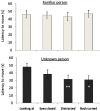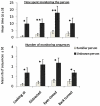Do horses have a concept of person? - PubMed (original) (raw)
Do horses have a concept of person?
Carol Sankey et al. PLoS One. 2011.
Abstract
Background: Animals' ability for cross-modal recognition has recently received much interest. Captive or domestic animals seem able to perceive cues of human attention and appear to have a multisensory perception of humans.
Methodology/principal findings: Here, we used a task where horses have to remain immobile under a vocal order to test whether they are sensitive to the attentional state of the experimenter, but also whether they behave and respond differently to the familiar order when tested by a familiar or an unknown person. Horses' response varied according to the person's attentional state when the order was given by an unknown person: obedience levels were higher when the person giving the order was looking at the horse than when he was not attentive. More interesting is the finding that whatever the condition, horses monitored much more and for longer times the unknown person, as if they were surprised to hear the familiar order given by an unknown voice.
Conclusion/significance: These results suggest that recognition of humans may lie in a global, integrated, multisensory representation of specific individuals, that includes visual and vocal identity, but also expectations on the individual's behaviour in a familiar situation.
Conflict of interest statement
Competing Interests: The authors have declared that no competing interests exist.
Figures
Figure 1. Obedience levels in response to the vocal order: time (s) spent immobile after being given the vocal command “stay!” by the familiar and unknown persons (max: 60 s).
Error bars represent standard errors. Wilcoxon _t_-tests, * P<0.05, ** P<0.01.
Figure 2. Mean number of monitoring (i.e. head rotations of approximately 45° or more towards the trainer during the time of immobility) sequences and mean monitoring duration (s) during the tests in the different conditions with the familiar and the unknown persons.
Error bars represent standard errors. * P<0.05, ** P<0.01.
Similar articles
- Cross-modal recognition of human individuals in domestic horses (Equus caballus).
Lampe JF, Andre J. Lampe JF, et al. Anim Cogn. 2012 Jul;15(4):623-30. doi: 10.1007/s10071-012-0490-1. Epub 2012 Apr 13. Anim Cogn. 2012. PMID: 22526687 - Cross-modal individual recognition in domestic horses (Equus caballus) extends to familiar humans.
Proops L, McComb K. Proops L, et al. Proc Biol Sci. 2012 Aug 22;279(1741):3131-8. doi: 10.1098/rspb.2012.0626. Epub 2012 May 16. Proc Biol Sci. 2012. PMID: 22593108 Free PMC article. - Horses (Equus caballus) use human local enhancement cues and adjust to human attention.
Krueger K, Flauger B, Farmer K, Maros K. Krueger K, et al. Anim Cogn. 2011 Mar;14(2):187-201. doi: 10.1007/s10071-010-0352-7. Epub 2010 Sep 16. Anim Cogn. 2011. PMID: 20845052 - Recognizing People in Motion.
Yovel G, O'Toole AJ. Yovel G, et al. Trends Cogn Sci. 2016 May;20(5):383-395. doi: 10.1016/j.tics.2016.02.005. Epub 2016 Mar 24. Trends Cogn Sci. 2016. PMID: 27016844 Review. - Cognition and learning in horses (Equus caballus): What we know and why we should ask more.
Brubaker L, Udell MA. Brubaker L, et al. Behav Processes. 2016 May;126:121-31. doi: 10.1016/j.beproc.2016.03.017. Epub 2016 Mar 24. Behav Processes. 2016. PMID: 27018202 Review.
Cited by
- The Responses of Young Domestic Horses to Human-Given Cues.
Proops L, Rayner J, Taylor AM, McComb K. Proops L, et al. PLoS One. 2013 Jun 19;8(6):e67000. doi: 10.1371/journal.pone.0067000. Print 2013. PLoS One. 2013. PMID: 23840572 Free PMC article. - Social Referencing in the Domestic Horse.
Schrimpf A, Single MS, Nawroth C. Schrimpf A, et al. Animals (Basel). 2020 Jan 18;10(1):164. doi: 10.3390/ani10010164. Animals (Basel). 2020. PMID: 31963699 Free PMC article. - Are horses capable of mirror self-recognition? A pilot study.
Baragli P, Demuru E, Scopa C, Palagi E. Baragli P, et al. PLoS One. 2017 May 16;12(5):e0176717. doi: 10.1371/journal.pone.0176717. eCollection 2017. PLoS One. 2017. PMID: 28510577 Free PMC article. - Emotion Recognition in Cats.
Quaranta A, d'Ingeo S, Amoruso R, Siniscalchi M. Quaranta A, et al. Animals (Basel). 2020 Jun 28;10(7):1107. doi: 10.3390/ani10071107. Animals (Basel). 2020. PMID: 32605256 Free PMC article. - Farm Animal Cognition-Linking Behavior, Welfare and Ethics.
Nawroth C, Langbein J, Coulon M, Gabor V, Oesterwind S, Benz-Schwarzburg J, von Borell E. Nawroth C, et al. Front Vet Sci. 2019 Feb 12;6:24. doi: 10.3389/fvets.2019.00024. eCollection 2019. Front Vet Sci. 2019. PMID: 30838218 Free PMC article. Review.
References
- Adachi I, Kuwahata H, Fujita K. Dogs recall their owner's face upon hearing their owner's voice. Anim Cogn. 2007;10:17–21. - PubMed
- Xitco MJ, Gory JD, Kuczaj SA. Dolphin pointing is linked to the attention behaviour of a receiver. Anim Cogn. 2004;7:231–238. - PubMed
- Hattori Y, Kuroshima H, Fujita K. I know you are not looking at me: capuchin monkey's (Cebus apella) sensitivity to human attentional states. Anim Cogn. 2007;10:141–148. - PubMed
Publication types
MeSH terms
LinkOut - more resources
Full Text Sources

